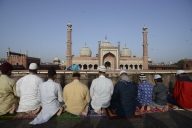By Charu Bahri
Despite almost trebling in the decade ending 2010 — from 5.2 per cent to 13.8 percent — the rate of Muslim enrolment in higher education trailed the national figure of 23.6 per cent, other backward classes (22.1 per cent) and scheduled castes (18.5 per cent). Scheduled tribes lagged Muslims by 0.5 per cent.
In proportion to their population, Muslims were worse-off than scheduled castes (SCs) and scheduled tribes (STs). Muslims comprise 14 per cent of India’s population but account for 4.4 per cent of students enrolled in higher education, according to the 2014-15 All India Survey on Higher Education.
 The situation has worsened over the last half century, according to the 2006 Sachar Committee, appointed to examine the social, economic and educational status of the Muslim community.
The situation has worsened over the last half century, according to the 2006 Sachar Committee, appointed to examine the social, economic and educational status of the Muslim community.
In the decade since then, the gross enrolment rate of Muslims doubled from 6.84 per cent to 13.8 per cent. Despite this, they trail the national average.
The 147 per cent increase in SCs and 96 percenet increase in STs in higher education enrolments — which still lags their proportion in the general population — since 2001 is the outcome of affirmative action, as we explained in part one of this series. The second part described how the proportion of other backward classes (OBCs) in higher education is now almost the same as their corresponding share of the general population.
So, should reservation be extended to Muslims?
That is not an easy question to answer. In a nation declared secular by its constitution, educational institutions are disallowed from discriminating between students on religious grounds. However, states can tweak constitutionally-mandated reservation provisions to provide “for the advancement of any socially and educationally backward classes of citizens or for the scheduled castes and the scheduled tribes”.
Where such reservations have been made for Muslims over and above the few Muslim castes included in the OBC list, such as in Kerala, Karnataka and Andhra Pradesh, their representation in higher education is three times the rate in non-minority institutions up North, according to Indian Muslims and Higher Education: A Study of Select Universities in North and South India, a 2013 comparative analysis.
Affirmative action has allowed many families to see their first-generation of graduates, post-graduates and doctorates. It has spurred progressive families to widen their horizons.
Poverty holds back Muslims from higher education — but not in south India
There is little doubt that Muslims are among India’s most economically disadvantaged communities. Hindus who are not classified backward and other minorities spent 60 per cent more than Muslims, according to the Sachar Committee.
No more than 81 per cent of urban male Muslims are literate, the lowest literacy rate among urban males from Indian religious groups — Hindus (91 per cent), Christians (94 per cent), Sikhs (86 per cent) and Others (95 per cent) — according to Employment and Unemployment Situation among Major Religious Groups in India, a 2010 National Sample Survey Office (NSSO) report.
In higher education, Muslims (13.8 per cent) trailed all the major religions in gross enrolment rate in 2010 — Hindus (24.2 per cent), Christians (36.9 per cent) and others (Jains, Sikhs et al) (28 per cent).
Among Muslims, the work participation rate, another key determinant of socio-economic well-being, representing the workforce per 1000 population, was the lowest of all the major religions-536, below Sikhs (568), Christians (540), Hindus (563) and Others (573), also according to NSSO 2010.
In the North, lack of schools holds back Muslims from higher education
“There is a spectacular ‘digital divide’ between South and North Indian Muslims in terms of education, and thereby in political empowerment,” wrote Syed Iqbal Hasnain — former vice chancellor of the University of Calicut and a distinguished visiting fellow of the US’ Stimson Center, a nonprofit — in a 2009 book, Muslims in North India: Frozen in the Past.
“South Indian Muslims, particularly of Kerala, Tamil Nadu, Andhra Pradesh, Karnataka and Maharastra have shown impressive progress in education, compared to their counterparts in Bihar, UP (Uttar Pradesh), Madhya Pradesh, Rajasthan, Jammu and Kashmir and Haryana,” wrote Hasnain.
Affirmative action in south India is only one reason for this divide.
In south India, a push for education — particularly by local leaders — has boosted enrolment at all levels.
In contrast, Muslims in north India have fewer schools to access.
Muslim school drop-outs: those who never make it to the higher education threshold
Across India, half of Muslim children who complete middle school drop out during secondary school, according to the Sachar Committee.
The drop-out rate among Muslims is higher than the general population: 17.6 per cent, compared to the all-India average of 13.2 per cent, according to a 2014 study based on 2005-06 National Family Health Survey (NFHS) data.
In Rajasthan, 18.5 per cent of Muslim primary school students dropped out, as did 20.6 per cent upper primary students, compared to the state averages of 8.4 per cent and six per cent, according to a 2013-14 survey by the state’s district information system for education and independent bodies.
“High drop-out rates among Muslims, especially after middle school, are to blame for the community’s small pool of youth eligible for higher education — and therefore, low share of higher education enrolments,” said Rakesh Basant, professor of economics at Indian Institute of Management-Ahmedabad, and a member of the Sachar Committee.
Correspondingly, Basant advocates “supply side interventions”, such as scholarships for students and good neighbourhood schools, to ensure more Muslim children pursue higher education.
(In arrangement with IndiaSpend.org, a data-driven, non-profit, public interest journalism platform. Charu Bahri is a freelance writer and editor based in Mount Abu, Rajasthan. The views expressed are those of IndiaSpend.)













